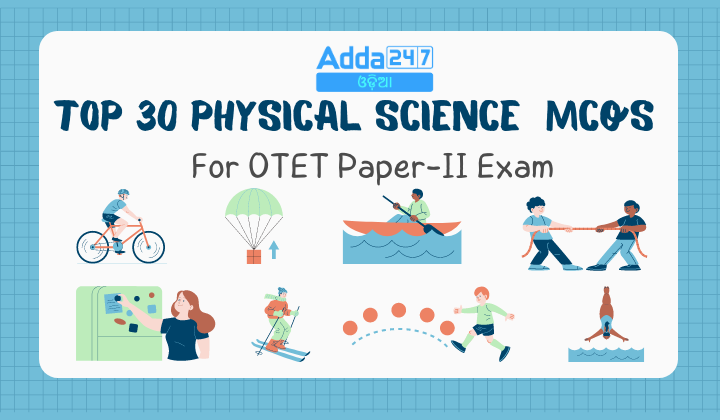The “Top 30 Physical Science MCQs for OTET Paper-II Exam” cover essential concepts such as metals, non-metals, and metalloids, elements and compounds, symbols, valence, and chemical equations. They also include acids, bases, and salts, physical and chemical changes, force, motion, friction, and pressure in solids, liquids, and gases. Additional topics are electricity, current, the chemical effects of electric current, the refraction and reflection of light, and the solar system and planets. These MCQs are designed to help candidates master critical principles, ensuring comprehensive preparation for the OTET exam’s Physical Science section.
Top 30 Physical Science MCQS For OTET Paper- II Exam
Q1. When a car suddenly stops, the passengers tend to lunge forward. This phenomenon can be explained by:
a) Newton’s First Law
b) Newton’s Second Law
c) Newton’s Third Law
d) Law of Conservation of Momentum
Answer: a) Newton’s First Law
Explanation: Newton’s First Law (the law of inertia) states that an object in motion stays in motion unless acted upon by an external force.
Q2. Which metal is most commonly used in electrical wiring due to its excellent conductivity?
a) Aluminum
b) Gold
c) Copper
d) Silver
Answer: c) Copper
Explanation: Copper is widely used in electrical wiring because of its high electrical conductivity and relatively low cost.
Q3. Which non-metal is essential for respiration in humans?
a) Nitrogen
b) Oxygen
c) Helium
d) Neon
Answer: b) Oxygen
Explanation: Oxygen is crucial for human respiration as it is used in the process of cellular respiration to produce energy.
Q4. Which of the following elements is a liquid non-metal at room temperature?
a) Bromine
b) Chlorine
c) Iodine
d) Fluorine
Answer: a) Bromine
Explanation: Bromine is a liquid at room temperature and is a non-metal.
Q5. Which of the following elements is classified as a transition metal?
a) Sodium
b) Calcium
c) Iron
d) Argon
Answer: c) Iron
Explanation: Iron is a transition metal, found in the d-block of the periodic table.
Q6. Which of the following indicates a chemical change?
a) Change in shape
b) Change in state
c) Formation of gas
d) Change in size
Answer: c) Formation of gas
Explanation: Formation of gas indicates a chemical reaction has occurred, leading to a chemical change.
Q7. Which of the following is a compound?
a) Gold
b) Sulfur
c) Sodium chloride
d) Oxygen
Answer: c) Sodium chloride
Explanation: Sodium chloride (NaCl) is a compound formed from sodium and chlorine.
Q8. What is the simplest form of a chemical substance?
a) Compound
b) Mixture
c) Solution
d) Element
Answer: d) Element
Explanation: Elements are the simplest form of chemical substances and cannot be broken down into simpler substances.
Q9. The formation of rust on iron is an example of:
a) Physical change
b) Chemical change
c) Both physical and chemical changes
d) No change
Answer: b) Chemical change
Explanation: Rusting is a chemical change where iron reacts with oxygen to form iron oxide.
Q10. The compound CH4 is known as:
a) Ethanol
b) Methane
c) Propane
d) Butane
Answer: b) Methane
Explanation: Methane is a simple hydrocarbon with one carbon and four hydrogen atoms.
Q11.What is the unit of force in the International System of Units (SI)?
a) Joule
b) Watt
c) Newton
d) Pascal
Answer: c) Newton
Explanation: The unit of force in SI is the Newton (N).
Q12. What is the valency of carbon in methane (CH4)?
a) 2
b) 3
c) 4
d) 5
Answer: c) 4
Explanation: Carbon has a valency of 4 in methane, forming four single covalent bonds with hydrogen.
Q13. Which of the following represents a balanced chemical equation?
a) H2 + O2 → H2O
b) 2H2 + O2 → 2H2O
c) H2 + 2O2 → H2O2
d) H2+ O → H2O
Answer: b) 2H2 + O2 → 2H2O
Explanation: This equation is balanced, with equal numbers of each type of atom on both sides.
Q14. Which of the following is an example of static friction?
a) A car moving on a highway
b) A book resting on a table
c) A ball rolling on the ground
d) A fish swimming in water
Answer: b) A book resting on a table
Explanation: Static friction acts on objects that are not moving, such as a book resting on a table.
Q15. Which of the following elements has a valency of 1?
a) Oxygen
b) Chlorine
c) Calcium
d) Nitrogen
Answer: b) Chlorine
Explanation: Chlorine has a valency of 1, meaning it typically forms one covalent bond or gains one electron.
Q16. What is the pH of a neutral solution?
a) 0
b) 7
c) 14
d) 4
Answer: b) 7
Explanation: A neutral solution has a pH of 7, indicating neither acidic nor basic properties.
Q17. Which of the following is a strong acid?
a) NaOH
b) HCl
c) NH3
d) CH3COOH
Answer: b) HCl
Explanation: Hydrochloric acid (HCl) is a strong acid.
Q18. Which compound is commonly used as a base in household cleaning products?
a) NaCl
b) H2SO4
c) NaOH
d) H2O
Answer: c) NaOH
Explanation: Sodium hydroxide (NaOH) is commonly used in cleaning products due to its strong basic properties.
Q19. Which of the following salts is used in food preservation?
a) NaCl
b) KCl
c) MgCl2
d) CaCl2
Answer: a) NaCl
Explanation: Sodium chloride (NaCl), or common table salt, is widely used in food preservation.
Q20. The neutralization reaction between an acid and a base produces:
a) Salt and water
b) Salt and hydrogen
c) Acid and base
d) Water and hydrogen
Answer: a) Salt and water
Explanation: Neutralization reactions between acids and bases typically produce a salt and water.
Q21. Which of the following is a physical change?
a) Rusting of iron
b) Burning of wood
c) Melting of ice
d) Baking a cake
Answer: c) Melting of ice
Explanation: Melting of ice is a physical change because it only changes the state of water from solid to liquid.
Q22. Which process involves a chemical change?
a) Dissolving sugar in water
b) Boiling water
c) Photosynthesis in plants
d) Melting wax
Answer: c) Photosynthesis in plants
Explanation: Photosynthesis is a chemical change where light energy is converted into chemical energy.
Q23. Sound waves in air are:
A) Transverse
B) Longitudinal
C) Electromagnetic
D) Polarized
Answer: B) Longitudinal
Explanation: Sound waves in air are longitudinal because the particles of the medium through Q24. which the sound travels vibrate parallel to the direction of wave propagation.
Planets are:
A) Luminous heavenly bodies revolving around a star
B) Non-luminous heavenly bodies
C) Luminous heavenly bodies that twinkle
D) Luminous heavenly bodies that do not twinkle
Answer: B) Non-luminous heavenly bodies
Explanation: Planets are non-luminous because they do not produce their own light but reflect the light of a star, such as the Sun.
Q25. Light from the Sun reaches us in nearly:
A) 2 minutes
B) 4 minutes
C) 8 minutes
D) 16 minutes
Answer: C) 8 minutes
Explanation: Light from the Sun takes approximately 8 minutes to reach the Earth due to the average distance of 149.6 million kilometers between the Earth and the Sun.
Q26. Magnetism at the center of a bar magnet is:
A) Minimum
B) Maximum
C) Zero
D) Minimum or Maximum
Answer: C) Zero
Explanation: At the center of a bar magnet, the magnetic field is zero because the magnetic poles are at the ends of the magnet, where the magnetic force is concentrated.
Q27.If electrical conductivity increases with the increase of temperature of a substance, then it is a:
A) Conductor
B) Semiconductor
C) Insulator
D) Carburetor
Answer: B) Semiconductor
Explanation: In semiconductors, electrical conductivity increases with an increase in temperature due to the increased movement of charge carriers (electrons and holes).
Q28. Which law is also called the law of inertia?
A) Newton’s First Law
B) Newton’s Second Law
C) Newton’s Third Law
D) All of these
Answer: A) Newton’s First Law
Explanation: Newton’s First Law states that an object will remain at rest or in uniform motion unless acted upon by an external force, which is why it is known as the law of inertia.
Q29. Which one of the following has the highest value of specific heat?
A) Alcohol
B) Methane
C) Kerosene
D) Water
Answer: D) Water
Explanation: Water has the highest specific heat capacity, meaning it requires more heat to increase its temperature compared to most substances.
Q30. Which instrument is used to measure altitudes in aircraft?
A) Audiometer
B) Ammeter
C) Altimeter
D) Anemometer
Answer: C) Altimeter
Explanation: An altimeter is used to measure the altitude of an object above a fixed level, often used in aircraft to determine altitude.
The absorption of ink by blotting paper involves:
A) Capillary action phenomenon
B) Viscosity of ink
C) Siphon action
D) Diffusion of ink through the blotting
Answer: A) Capillary action phenomenon
Explanation: Blotting paper absorbs ink through capillary action, which is the ability of a liquid to flow in narrow spaces without the assistance of external forces.










